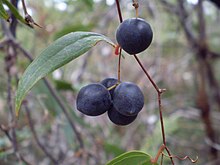| Sweet sarsaparilla | |
|---|---|

| |
| Scientific classification | |
| Kingdom: | Plantae |
| Clade: | Tracheophytes |
| Clade: | Angiosperms |
| Clade: | Monocots |
| Order: | Liliales |
| Family: | Smilacaceae |
| Genus: | Smilax |
| Species: | S. glyciphylla |
| Binomial name | |
| Smilax glyciphylla Sm. | |
Smilax glyciphylla, the sweet sarsaparilla, is a dioecious climber native to eastern Australia. It is widespread in rainforest, sclerophyll forest and woodland; mainly in coastal regions.
The leaves are distinctly three-veined with a glaucous under-surface, lanceolate, 4–10 cm long by 1.5–4 cm wide. Coiling tendrils are up to 8 cm long. The globose berries are 5–8 mm in diameter, black with a singular seed.
Uses
The fruit is edible. The sweet flavoured leaves are used medicinally by Indigenous people and non-Indigenous colonists, including as a tea substitute.
It was used medicinally in the earliest days of the colony of Port Jackson for treating scurvy, coughs and chest complaints. In correspondence to England in November 1788, Dennis Considen wrote: "I have sent you some of the sweet tea of this country which I recommended and is generally used by the marines and convicts as such it is a fair antiscorbutic as well as a substitute for tea which is more costly."
It was recommended as a tea alternative, tonic and antiscorbutic, and was still being traded at least up until the late 19th century by Sydney herbalists. It is claimed to have similar properties to Jamaican sarsaparilla, Smilax regelii.
The leaves, stems, and flowers contain the glycoside glyciphyllin, which has a bitter-sweet taste and may be the active medicinal component.
Recent research shows that S. glyciphylla has antioxidant activity.
Gallery
Images of Smilax glyciphylla-
 Leaves of Smilax glyciphylla showing three prominent veins. Drawing Room Rocks Track, near Berry, NSW.
Leaves of Smilax glyciphylla showing three prominent veins. Drawing Room Rocks Track, near Berry, NSW.
References
- Smilax glyciphylla plant profile, PlantNET
- Lassak, E.V., & McCarthy, T., Australian Medicinal Plants, Methuan Australia, pp91-92, 1983, ISBN 0-454-00438-9.
- White, J., Journal of a Voyage to New South Wales, 1790
- Copy of letter received by Dr Anthony Hamiltion, from Dennis Considen, 18 November 1788, and sent onto Joseph Banks. archived from the original 13 March 2011 at the Wayback Machine.
- Maiden, J.H., The Useful Plants of Australia, 1889, p203.
- Rennie, E.H., Glyciphyllin, the sweet principle of Smilax glyciphylla, Journal of the Chemical Society Journal Transactions, 49, 1886.
- Maiden, J.H., The Useful Plants of Australia, 1889, p203-204.
- Hegnauer, R., Chemotaxonomie der Pflanzen, vol. 2, Birkhauser Verlag, Basel, 1963.
- Cox, S.D., Jayasinghea, K.C., and Markhama, J.L., Antioxidant activity in Australian native sarsaparilla (Smilax glyciphylla), Journal of Ethnopharmacology, Vol. 101, Issues 1-3, 3 October 2005, pp162-168.